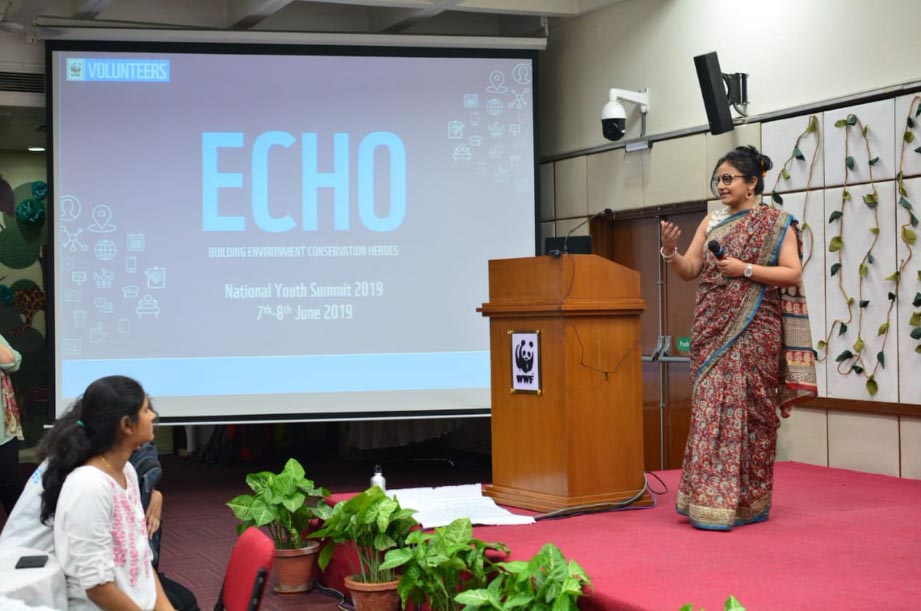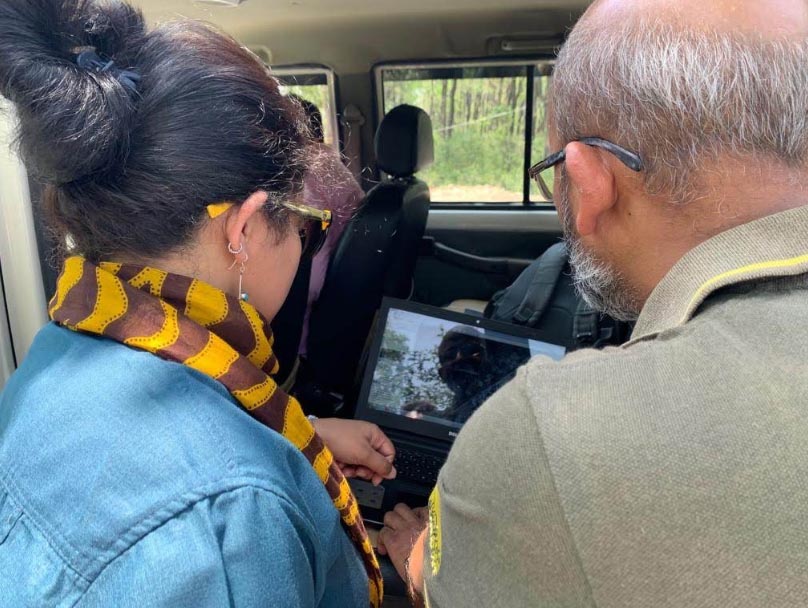WWF India’s conservation expert Ambika candidly speaks about her journey into the world of development and conservation in an interview with Aishwarya Das Pattnaik for the Humans of WWF India series.
India has been walloped with the second wave of Covid-19. Likewise, we are also at the threshold of witnessing severe climatic weather events across the country. From raging forest fires, rising sea levels to devastating cyclones – our natural world is becoming vulnerable. While safeguarding public health needs immediate support, rebuilding lives, livelihoods and nature are of great importance.
The rippling effects of a pandemic coupled with extreme weather events have crushed years of development. Presently, this is the worst crisis we have faced in decades.
Ecosystem degradation can increase contact between humans and wildlife. It has also been linked to outbreaks of deadly diseases. However, halting the speed of these anthropogenic changes will build pathways to boost the economy and maintain safer public health and security.
In the Humans of WWF India series, we get to know about Ambika, who is often known to many as a “problem solver.” She and her team have been working tirelessly to promote on-ground conservation actions and policies to prevent habitat loss and degradation.
 With a Ph.D. in Ecosystem Planning, Ambika brings on board two decades of experience to address vital interventions required at both policy and programme levels
With a Ph.D. in Ecosystem Planning, Ambika brings on board two decades of experience to address vital interventions required at both policy and programme levels
“[I] was raised in a household where education and learning is and was very deeply embedded. Over my academic years, I pursued two full time Master's degrees from technical institutions like the School of Planning and Architecture and the Delhi School of Economics and along the way even completed courses in human resource management and then journalism. All this active degree seeking was finally wrapped up in a PhD on Ecosystem Planning while working full time at the Canadian IDRC but online learning continues especially in this pandemic world. My mother would often worry about me. But my father would appease her and strongly believed in whatever I was doing. He was sure that I would find my calling soon,” she recalls fondly.
“My first job was with Development Alternatives (DA). And you'd be pleasantly surprised to know that post all those technical degrees I was hired to design websites! I was also working in the field to promote sustainable development and conducted several household surveys in over 200 villages back then. In the year 1999, there were very few organisations let alone NGOs with dedicated websites. I remember talking about websites in my interview and clearly mentioning WWF and Nat Geo’s websites as examples of what I had seen. For me, it is cosmic! Life made a full circle, and now I work with WWF India!” explains Ambika, chuckling.
A multi-tasker, her expertise expands into crosscutting functionalities, including designing social behaviour change campaigns and implementing change management strategies and fundraising. Over her years in the development sector, she has worked extensively to break complex concepts to connect and communicate better to a larger audience.
This year's World Environment Day launches the UN Decade on Ecosystem Restoration.

Reversing nature loss is critical to economic prosperity
"[We] are at a very critical point in time for this planet. At the other end of the spectrum, I think there's also a certain amount of awakening that's happening - people are stepping up for nature more than ever before. World Environment Day 2021 calls for urgent actions to revive our damaged ecosystems. Humans will only exist if our natural world exists, and not the other way around!" stresses Ambika.
Ambika further reminds us that the UN Decade is synonymous with a preamble for protecting nature. It runs from 2021 to 2030 - also the deadline for the Sustainable Development Goals.
"Scientists have identified this timeline for a reason - as it is humanity’s last chance to prevent anything attached to climate change. Look at WWF's Bending the Curve model – it clearly shows that if we don't prevent biodiversity loss in the next decade, it is downhill from there. An integrated approach towards bold conservation efforts is non-negotiable and central to build a world for people and nature to thrive. We have ten years to heal our planet. Policies and facts already exist. Right now, we need stronger political will and work towards active implementation," said Ambika.
“The benefits of restoring natural resources outweigh the cost tenfold, and the cost of inaction is even higher. Do you know, $44 trillion of economic value generation – over half the world’s total GDP – is moderately or highly dependent on nature and its services and, as a result, is exposed to risks from nature loss, according to a World Economic Forum report. Now we know reversing nature loss is critical to economic prosperity.”
While restoring and reversing ecosystems in cities is a daunting task. Yet, it is not impossible. She explains about two kinds of regeneration theories - natural regeneration and assisted regeneration. “As an environmental planner, I believe if you let nature be, it will restore itself. Stop using a particular man-made facility, and allow the ecosystem to grow back. For instance, globally, reclamation has been tried for railway lines, roads & other structures. In cities, urban biodiversity has always existed. Today our country is in this new phase of urbanisation. Growth is no longer limited to former cosmopolitan metro regions but new urban centres in Tier 2 or 3 smaller towns.”
Revisiting Master Plans, especially in cities that are in the vicinity of critical landscapes with higher ecological value, must plan for interconnected green spaces according to Ambika. “In your head, you have to think of a mosaic, where there are four or five cities and in between those cities, there are forests along with little wetland pockets within it. Building interconnected green hubs are the way forward for cities to promote urban biodiversity and landscape continuity.”
 In action: Working on a landscape-level conservation planning in the Terai
In action: Working on a landscape-level conservation planning in the Terai
WWF-India’s role as a knowledge partner is now well established with the town planning body and government nodal development agencies in Uttarakhand.
“Our land use and urbanisation team has been providing regular inputs on integrating environmental dimensions in the planning processes on-going in the State since 2018. This effort has also included a concerted effort to provide technical support to the landscape teams on linear infrastructure projects coming up in the State. We are confident and committed to promoting an integrated landscape approach in the region,” states Ambika.
 Seen here is the rejuvenated Bashettihalli wetland in Bengaluru rural district, Karnataka.
Seen here is the rejuvenated Bashettihalli wetland in Bengaluru rural district, Karnataka.
“Last year, the Bashettihalli wetland, located in Bengaluru rural district, received water after more than a decade due to community-led rejuvenation! We facilitated the project in association with partners. Our success would not have been possible without the contribution and cooperation of local communities. Similarly, over 300 farmers in Bijnor district, Uttar Pradesh, united to revive River Karula, a tributary of Ramganga. For three years, through the adoption of better irrigation management practices, farmers augmented ~53 million litres of saved water into River Karula. It is evident that together it is possible in reviving, rejuvenating, and restoring our natural world,” she implied confidently.

United to revive River Karula, a tributary of Ramganga
Restoring landscapes in a way that meets the needs of people and nature is not an easy task. But as our new report, Twenty years later: Lessons learnt from forest landscape restoration projects worldwide, shows, it is fully possible.
WWF is proud to join the UN Decade on Ecosystem Restoration as a global partner. Our reason is simple: we have no hope of tackling climate change, the loss of wildlife, and human health and prosperity without large-scale ecosystem restoration.
She feels extremely strongly and passionately that the youth need to power this decade of restoration. Ambika also concedes that “young people and youth advocates need to call out for a paradigm shift and reforms in every sector”. She says that from agriculture, conservation and financial markets to careers and more have a role to tackle the climate crisis.